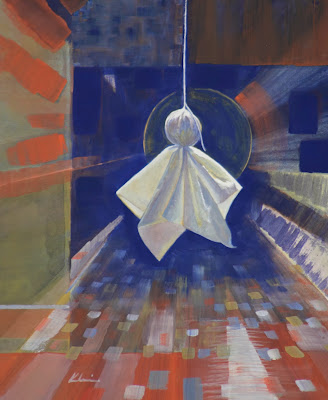In a comment on the
previous post,
Olga wrote, "Can I ask, by the way, why you use casein? Is it a simple case of you like the effect?"
Her questions gave me pause, the chance to gather my thoughts on the subject and to pull together some of the references I've been using lately. Thank you, Olga.
Casein fine art painting was first introduced to me, and to many other contemporary artists, by James Gurney on his blog,
Gurney Journey. I hadn't thought about milk-based paint as an artistic medium until I saw a painting Gurney did of a
chrome creamer at a restaurant booth in only black and white casein. I was quite smitten by this little painting - Gurney's work is amazingly compelling and sincere. His blog has a lot of posts dedicated to the medium with some great information on tools and materials. I picked up a lot of useful tips there that got me started.
Timing was important with my switch too - I was ripe for change.
I had made a firm and deliberate decision to stop painting with lead white oil paint (for all of the obvious reasons) and had begun experimenting with alternative whites. But oil painting wasn't the same without my favorite white. I really was spoiled and was finding it hard making the change. In the middle of that struggle, in the middle of last June, an alternative solution presented itself. The time was right for me to give a new medium a serious try.
Since July 8, 2013, I've made 15 casein paintings (with
Richeson Casein - The Shiva Series) and have read numerous books, posts and articles about the medium. Finding those references wasn't easy. Here's a crop of a cover of one of the books I eventually did find:
It's a
Walter Foster how-to book from who-knows-when (there is absolutely no date in it - I've checked and rechecked and even had a close friend search for it.) I'm guessing it's from the 50's or 60's. See how the word "Acrylic" is superimposed over "Casein"? And remember the famous lines in the 1967 movie The Graduate, "I just want to say one word to you. Just one word. Plastics"? I'm guessing that casein was pushed out of the picture (and literally written over) in the 50's and 60's by the overwhelming popularity of acrylic (plastic) paint. It really does take some detective work to find information on it now because it had gone out of fashion so abruptly and completely last mid-century.
Personally, and from the limited time I've been painting in casein, I continue because it combines the best of both watercolor and oils while providing me the comfort and assurance that I'm painting with the healthiest paint for myself, my family and the environment. And I love it - the feel, the smell, the colors, the sumptuous matte surface it becomes and the painterly way I attack the surface now with only brush, paint and idea. I feel safe and free to paint like I've never painted before.

















































